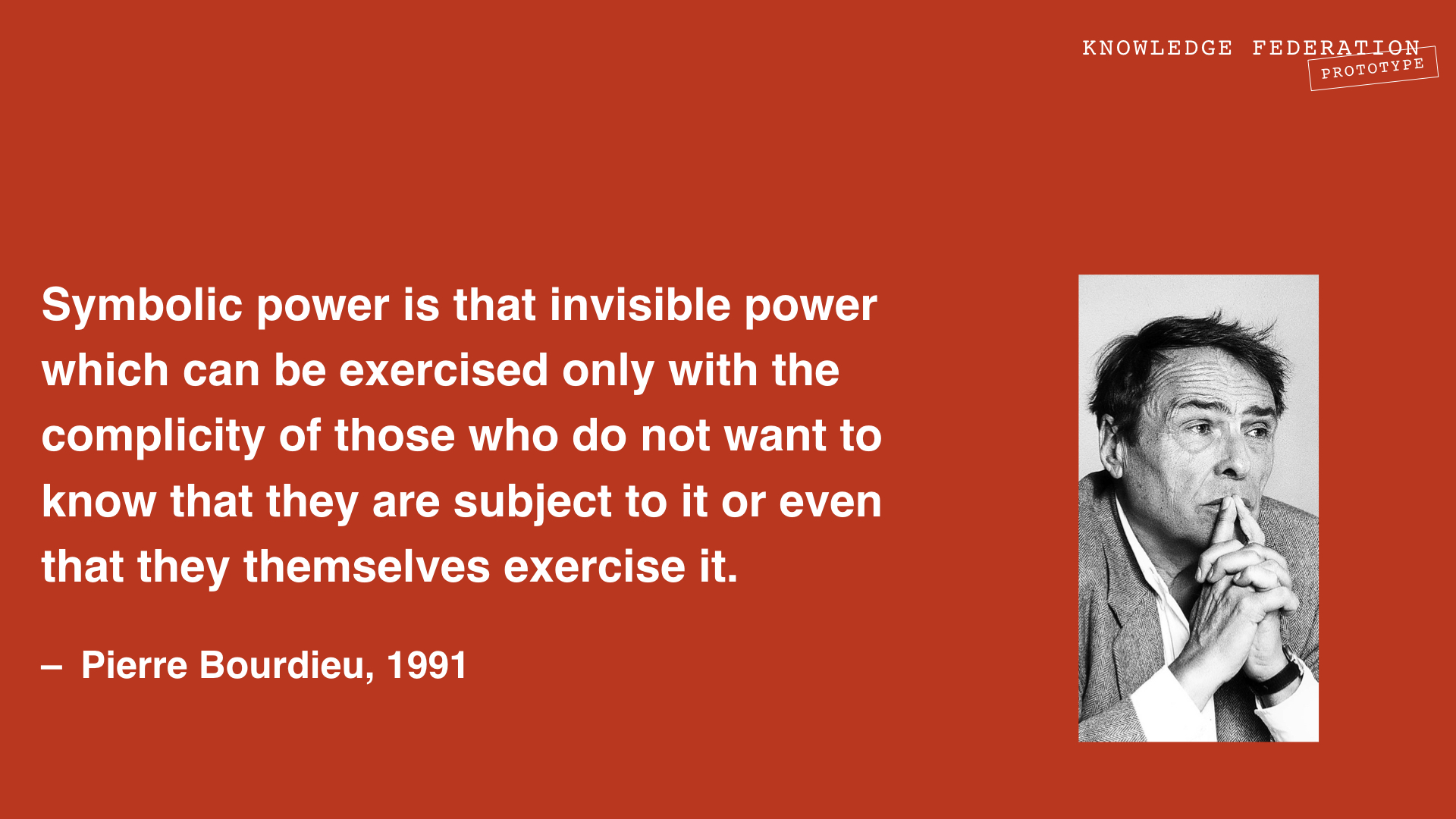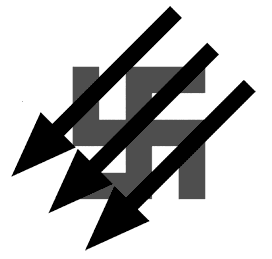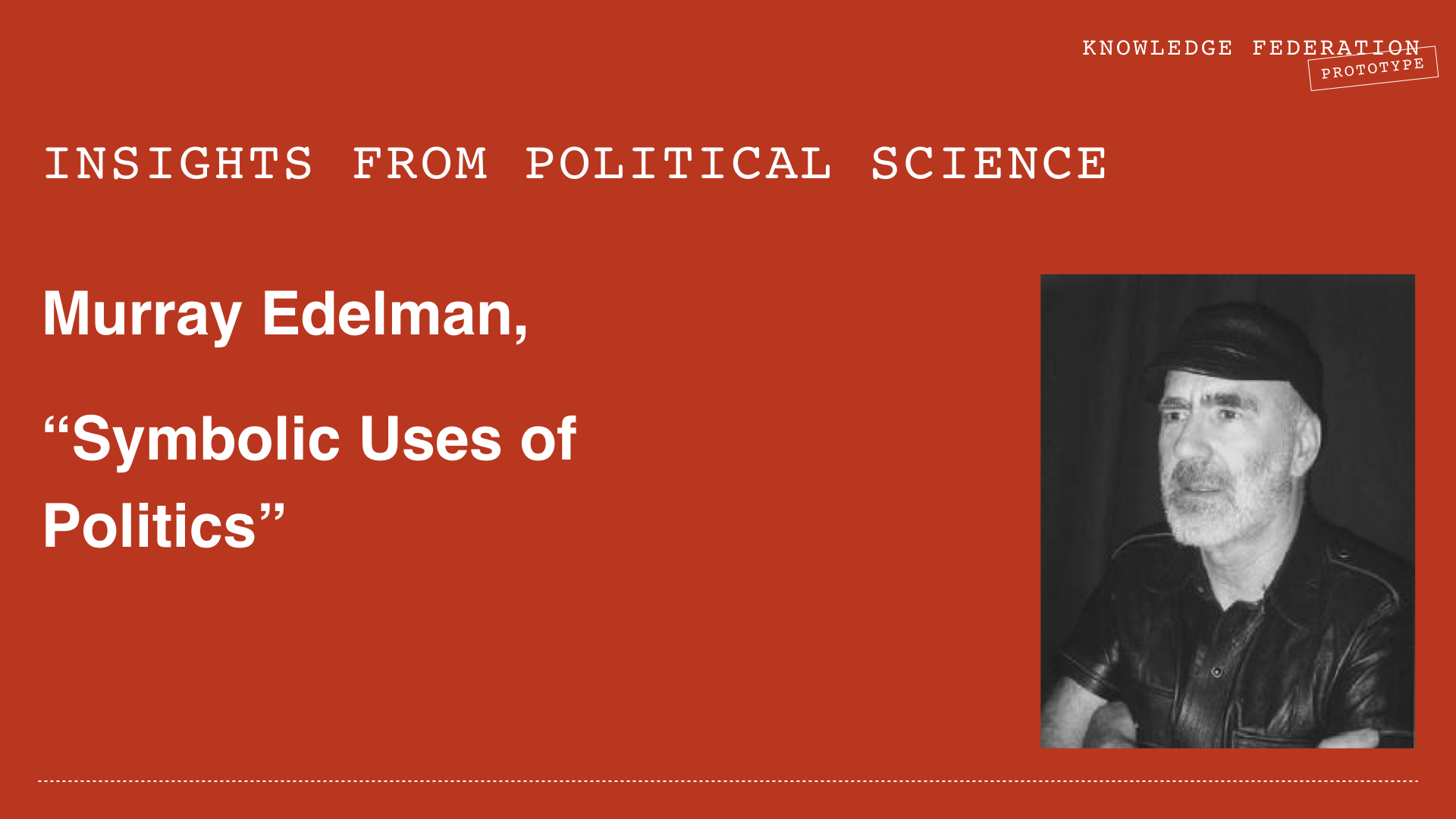Holotopia: Socialized reality
Contents
- 1 H O L O T O P I A: F I V E I N S I G H T S
- 2 Socialized reality
- 2.1 Stories
- 2.2 A clue to cultural revival
- 2.3 Reality and beyond
- 2.4 "Reality" is a myth
- 2.5 "Reality" is an instrument of socialization
- 2.6 "Reality" is a product of power structure
- 2.7 Understanding socialization
- 2.8 Who keeps Galilei in house arrest
- 2.9 Socialized reality in popular culture
- 2.10 We are not yet free
- 2.11 Ideogram
- 2.12 The mirror points to a leverage point
- 2.13 Our point
- 2.14 Keywords
- 2.15 Reification, truth by convention and design epistemology
- 2.16 Information and implicit information
- 2.17 Prototypes
- 2.18 Visual literacy definition
H O L O T O P I A: F I V E I N S I G H T S
Socialized reality
Here we'll talk about the core of our proposal—to change the very relationship we have with information. And through information, the relationship we have with the world; and with ourselves.
The relationship we have with information, and through information with the world and with ourselves, is founded on unstated beliefs and values. Like the foundations of a house, they hold the entire edifice of our culture, while themselves remaining invisible. That's why we call them simply foundations.
Needless to say, a cultural revival is really just a natural result of a fundamental shift in those foundations. Wasn't that what the Renaissance, and the Enlightenment, were really all about?
From the traditional culture we have adopted a myth, incomparably more subversive than the myth of creation. That myth now serves the foundation stone on which the edifice of our culture has been erected.
Stories
A clue to cultural revival
As movies tend to, Alain Resnais' "My American Uncle" follows its characters through strained relationships with parents, career ups and downs and love-related hopes and disappointments. But "My American Uncle" offers also a meta-narrative, which (we propose) turns it into a new paradigm art project.
In that way, the movie federates a socially relevant insight of a researcher, neuroscientist Henri Laborit. At the end of the movie, Laborit appears on the screen in person, and summarizes this insight:
The unconscious is a formidable instrument. Not only because it holds all that we have repressed, things too painful for us to express, because we'd be punished by society. But also because all that is authorized, even rewarded by society, has been placed in our brain since birth. We're unaware of its presence, and yet it guides our actions. This unconscious, which is not Freud's, is the most dangerous. What we call the personality of an individual is built up from a grab-bag of value judgments, prejudices and platitudes. As he grows older, they become more and more rigid, less and less subject to question. Take away one single stone from this edifice, and it all crumbles. The result is anguish. And anguish stops at nothing, neither murder, nor genocide, nor war, in the case of social groups.
We are beginning to understand by what mechanism, why and how, throughout the history and in the present, the hierarchies of dominance have been established. To go to the moon, we must know the laws of gravity. Knowing the laws of gravity doesn't make us free of gravity. It merely allows us to utilize it.
Until we have shown the inhabitants of this planet the way their brain functions, the way they use it, until they know it has always been used to dominate others, there is little chance that anything will change.
Reality and beyond
Did Moses really return from Mount Sinai with ten commandments, written in stone by God himself?
For centuries, our ancestors considered this a fact. But to a modern mind, the fact that this would violate "laws of physics" takes precedence.
When Nietzsche observed, famously, that "God is dead", he did not of course mean that God physically died. Or that the belief in God lost its foundation in our culture, which was obvious. What he meant was that we, as culture, lost a range of functions that had been founded on the belief in God.
An example are principles to live by. But not the only one.
A tradition includes not only principles, but also rituals, architecture, music, norms...—by which people are (let's use this word now) socialized to think and feel and behave in a certain way. To be in a certain way.
So Nietzsche's real, subtle and all-important point was that we have rebelled, and left our "father's" home. By doing that we have acquired not only a new freedom, but also a new set of responsibilities. We must now provide for ourselves. We must become a bit like the "father" was...
"Reality" is a myth
Our contemporary culture too is founded a popular belief—that "truth" means "correspondence with reality"; that "correspondence with reality" can be rationally verified; and that "the scientific worldview" is a result of such verification, and therefore "objectively true".
"Correspondence with reality" cannot be verified
In "Evolution of Physics", Einstein and Infeld explained why "correspondence to reality" cannot be rationally verified, by using the parable of a closed watch. Einstein, furthermore, held the position that the belief that the results of our speculation or reflection correspond to reality is a common product of illusion. Both arguments are summarized and commented [here].
Since our goal is not to give a new "objectively true reality picture", but only to submit a legitimate way of looking at our theme, nothing more needs to be said.
Our culture too has been founded on a myth
It follows that our culture too is founded on a myth.
This can easily be understood, and forgiven, if one takes into account that the belief that "truth" means "correspondence with reality" is deeply engrained in our 'cultural DNA', and even in our language. When I write "worldviews", my word processor underlines the word in red. The word "worldview" doesn't have a plural; since there is only one world, there can be only one worldview—the one that corresponds to that world.
"Reality" is an instrument of socialization
... the mother embracing a child, the decoration that will flatter the narcissism of a warrior, the applause that will accompany a narration of an actor. All this will free certain chemical substances in the brain and result in pleasure. (...) Finally, we need to be aware that what penetrates into our nervous system from birth and perhaps even before, in utero, the stimuli that will enter our nervous system come to us essentially from the others, and that we are the others. When we die, it will be the others that we've internalized in our nervous system, who have constructed us, who have constructed our brain, who have filled it up, that will die.
Bourdieu's theory of socialization
In his "theory of practice", Pierre Bourdieu gave us a comprehensive sociological theory of socialization. For now, let us represent it with a single word, doxa—which Bourdieu adopted from Max Weber, and whose usage dates all the way back to Plato. We mention this to suggest that doxa points to an idea that has deep roots and central function in the academia's history, which we'll come back to. Bourdieu uses this keyword to point to the experience—that the societal order of things we happen to live in constitutes the only possible one. "Orthodoxy" leaves room for alternatives, of which ours is the "right" one. Doxa ignores even the possibility of alternatives.
What makes a king "real"
The king enters the room and everyone bows. Naturally, you do that too. By nature and by culture, we humans are predisposed to do as others. Besides, something in you knows that if you don't bow down your head, you might lose it.
What is it, really, that makes the difference between "a real king", and an imposter who "only believes" that he's a king? Both consider themselves as kings, and behave accordingly. But the "real king" has the advantage that everyone else has been socialized to consider him as that.
While a "real king" will be treated with highest honors, an imposter will be incarcerated in an appropriate institution. Even though a single "real king" might have caused more suffering and destruction than all the imposters, and indeed all the historical criminals and madmen.
"Reality" is a product of power structure
Symbolic power
What strategy could be more effective for controlling us, for inhibiting our societal and cultural evolution ('keeping Galilei in house arrest'), then to construct the very worldview we collectively share and uphold as "reality"?
The story, which we have not yet told in sufficient detail, is about Bourdieu in Algeria, during Algeria's war against France for independence, and immediately after. There the circumstances allowed Bourdieu to observe how power morphed—from the traditional censorship, torture and prison, during the war, to become what Bourdieu called symbolic power, following the independence. The following vignette will suggest what Bourdieu actually saw.
Imagine a young Kabylian man who, driven by economic necessity, moved from his village to a city—only to discover that his entire way of being, which served him well, has become dysfunctional. Not only his sense of honor, but the very way he walks and talks are suddenly unappealing even to the young women from his very village—who saw something else in movies and in restaurants.
Bourdieu was reminded of his own experience—when he arrived to Paris, as an unusually gifted "hillbilly", to continue his education. He realized that the essence of power, and disempowerment, is not, and never was, as we the people tend to perceive it.
Symbolic power is part of power structure
Initially, we used to conflate symbolic power and power structure into a single concept—power structure. We later found it better to separate them—but let us now put them back together.
Throughout history, revolutions took place when people perceived the issue of justice and power in a new way, and saw themselves as unjustly disempowered. What we are witnessing here is a similar development taking place in our own time. Who 'keeps Galilei in prison' (hinders the progress of knowledge, and our evolution) today—without using any of the recognized instruments of power?
The Power Structure ideogram, shown on the right, depicts our 'political enemy' as a structure comprising power interests (represented by the dollar sign), our ideas about the world (represented by the book), and our own condition of wholeness (represented by the stethoscope).
File:Ower Structure.jpg
Power Structure ideogram
Understanding socialization
On The Paradigm Strategy poster, which was a predecessor to holotopia (described here), the mechanism of socialization is represented by the Odin–Bourdieu–Damasio thread (which we outlined here).
. In what follows we highlight the main ideas.</p></h3>Bourdieu's "theory of practice"</h3>
We condense it to a single keyword—"habitus". It is a generic keyword for embodied predispositions to think and act in a certain way, which tend to be transmitted directly, from body to body, as we suggested above. Someone has the habitus of a king; someone else "is" a serf, or a knight or a page. Imagine them together as comprising a symbolic turf—where each of us has a place.
Damasio's "Descartes' Error
Bourdieu's sociological theories synergize most beautifully with the ideas of cognitive neurosurgeon Antonio Damasio.
Damasio contributes a point—deftly coded into the very title of his book "Descartes' Error"—that we are not rational decision makers. The very contents of our rational mind (our priorities, and what options we are at all capable to conceive of and consider) are controlled by a cognitive filter—which is pre-rational. And embodied.
Damasio's theory completes Bourdieu's "theory of practice", by contributing the physiological mechanism by which the body-to-body socialization to conform to a given "habitus" extends into a doxa—that the given order of things, including our habitus, is just "reality".
Odin the horse
This real-life anecdote about the turf behavior of Icelandic horses serves to make introduce an interesting way of looking at the theme of power, with large potential impact—which is the following.
We have all been socialized to live in the "reality" where some are winners (kings) and others losers (serfs). But another way to see this is possible—where all of us are losers! And where the whole absurd game is indeed a result of a pathological and atavistic human tendency—to seek domination over others.
An alternative is, of course, human development. Of exactly the kind that the Buddha, Christ and so many other humanity's teachers have been pointing to.
Who keeps Galilei in house arrest
We did not really liberate ourselves from the power structure; and from the negative socialization it engender. Our socialization only changed hands—no longer the prerogative of the kings and the clergy, it is now used to subjugate it to new power holders.
This terrain is all too familiar. The anecdotes shared below will serve to remind us how we ended up needing so much human development; and a cultural revival.
Pavlov and Chakhotin
Pavlov's experiments on dogs (for which he was awarded the Nobel Prize) can serve us as a suitable metaphor for socialization
.
After having worked with Pavlov in his laboratory, Sergey Chakhotin participated in the 1932 German elections against Hitler. He noticed that Hitler was socializing German people to accept his ideas. He practiced, and advocated, the use non-factual or implicit information to counteract Hitler's approach (see an example on the right). Adding "t" to the familiar Nazi greeting produced "Heilt Hitler" (cure Hitler).
Later, in France, Chakhotin explained his insights about socializing people in a book titled "Viole des foules par la propagande politique"—see it commented here.
Edelman and symbolic action
Already in the 1960s the researchers knew that the conventional mechanisms of democracy (the elections) don't serve the purpose they were assumed to serve (distribution of power)—because (field research showed) the voters are unfamiliar with the candidates' proposed policies, the incumbents don't tend to fulfill their electoral promises and so on. Edelman contributed an interesting addition: It's not that the elections don't serve a purpose; it's just that this purpose is different from what's believed. The purpose is symbolic (they serve to legitimize the governments and the policies, by making people feel they were asked etc.)
“[G]overnmental authority needs not be, and typically is not, based on competence but rather on skill in manipulating the spectacle of building audiences and keeping them entertained.”
Have you been wondering what makes one qualified to become the President of the United States?
To political science, Edelman contributed a thorough study of the "symbolic uses of politics". A half-century ago.
Freud and Bernays
While Sigmund Freud was struggling to convince the European academics that we, humans, are not as rational as they liked to believe, his American nephew Edward Bernays had no difficulty convincing the American business that exploiting this characteristics of the human psyche is—good business. Today, Bernays is considered "the founder of public relations in the US", and of modern advertising. His ideas "have become standard in politics and commerce".
The four documentaries about Bernays' work and influence by Adam Curtis (click here) are most highly recommended.
Socialized reality in popular culture
As always, this core element present in our 'collective unconscious' (even if it has all too often eluded our personal awareness) has found various expressions in popular culture—as the following two examples will illustrate.
The Matrix
The Matrix is an obvious metaphor for socialized reality—where the "machines" (read power structures) are keeping people in a media-induced false reality, while using them as the power source. The following excerpt require no comments.
Morpheus: The Matrix is everywhere. It is all around us. Even now, in this very room. You can see it when you look out your window or when you turn on your television. You can feel it when you go to work... when you go to church... when you pay your taxes. It is the world that has been pulled over your eyes to blind you from the truth.
Neo: What truth?
Morpheus: That you are a slave, Neo. Like everyone else you were born into bondage. Into a prison that you cannot taste or see or touch. A prison for your mind.
Oedipus Rex
King Oedipus was not really a young man troubled by sexual attraction to his mother, as Freud may have made us believe. His problem was a conception that he was socialized to accept as reality—which drew him ever closer to a tragic destiny, as he was doing his best to avoid it.
A parable for our civilization?
We are not yet free
The task that is before us...
During the past century we have learned to harness the powers of ... NOW the largest one that remained...
Ideogram
The mirror points to a leverage point
OUR POINT: The academia — quest for knowledge — has its own powerful course. It has brought us to the metaphorical mirror.
The Mirror ideogram we use to summarize the academia's situation, pointing to a course of action—in a similar way as the Modernity ideogram summarizes the situation our society or civilization is in.
Our point
We Mirror ideogram as a visual shorthand symbolizes two pivotal changes in academia's situation: the ending of innocence, and the beginning of accountability.
The end of innocence
It is no longer legitimate to claim the innocence of "objective observers of reality". By seeing ourselves in the mirror, we see that it has along been just us looking at the world, and creating representations of it.
The beginning of accountability
When we see ourselves in the mirror, we see ourselves in the world.
We must pause and self-reflect
As a symbol for the situation, which the academia's evolution so far has brought us to, the mirror demands that we interrupt the academic business as usual and self-reflect—about the meaning and purpose of our work. A genuine academic dialog in front of the mirror is the core of our practical proposal, our call to action.
Enormous gains can be made
The change of the relationship we have with information, which is the core of our proposal, is here symbolized as a perfectly feasible yet seemingly magical next step—through the mirror!
To the proposed dialog in front of the mirror we are offering our two prototypes—of the holoscope and of the holotopia—as models of the academic and the social reality on the other side of the mirror.
Hence our overall proposal—the way we've federated the results of The Club of Rome as summarized by Peccei—is that the academia should step through the mirror; and guide our society to a completely new reality, which awaits on the other side.
Keywords
Reification, truth by convention and design epistemology
Truth by convention is the truth that suits the design order of things. It is the new foundation stone, to CONSISTENTLY replace reification. 'Archimedean point' for giving knowledge once again the power to 'move the world'.
Design epistemology is what the Modernity ideogram is suggesting—information, and the way we handle it, are considered pieces in a larger puzzle or puzzles. Not the "objective reality" puzzle, but the REAL reality...
Information and implicit information
Information is defined as "recorded experience". The point is that any kind of record of experience is information. So information can be either explicit (where something is explicitly stated or claimed), and implicit (such as the mores of the tradition, beliefs, values etc. etc.). The point of this definition is to broaden the scope.
Prototypes
Visual literacy definition
Visual literacy
In 1969, four visionary researchers saw the need, and initiated the International Visual Literacy Association. What exactly did they see? We introduce their ideas by the following ideogram, see it commented here.
In the above picture the implicit information meets the explicit information in a direct duel. Who wins? Since this poster is a cigarette advertising, the answer is obvious.
And so is this conclusion:
While the official culture is focused on explicit messages and rational discourse, our popular culture is being dominated, and created, by implicit information—the imagery, which we have not yet learned to rationally decode, and counteract.
This prototype is a systemic intervention on a number of levels:
- It showed how an existing academic discipline can be given an explicit definition—and hence a (non-traditional) purpose and orientation
- It showed how to make a definition whose purpose is not reification (defining X to allow for distinguishing what "is" and "is not" X), but perspective (understanding the big point, the purpose of it all)
- It defined visual literacy as literacy concerned with implicit information—and implicit information as the way in which culture tends to be created, as we saw above
Furthermore, like a similar initiative to define "design", this initiative was well received by the corresponding academic community.






